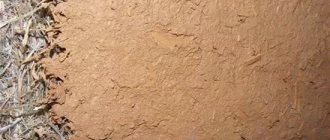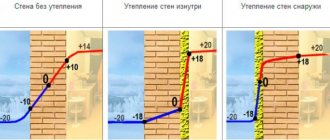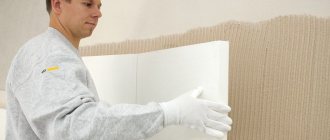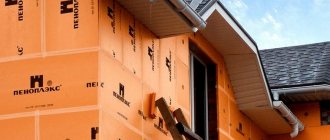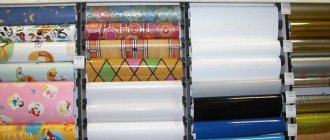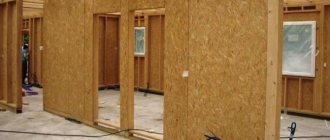If you have experienced the purchase or sale of apartments, then you have noticed that buyers do not really like corner apartments or rooms. What is this connected with? Although it is much easier to ventilate such an apartment in summer, the view from the windows opens on two or even three sides.
But there is one significant drawback. Very often, with the arrival of frost, residents of corner apartments suffer from insufficient heat. If the temperature outside is around zero, and the heating season has not yet begun, uncomfortable conditions are created inside such an apartment. Dampness appears in the corners, the windows fog up, the floor becomes cold, and the bed becomes damp.
The main reason for this is the presence of three walls that have access to the outside and are therefore most susceptible to low temperatures. In winter, even with central heating, the situation only gets worse.
The walls can freeze completely, especially in the corners, the interior decoration will begin to fall off, and mold and mildew will appear. Staying in such an apartment will not only be uncomfortable, but also unsafe, especially for children. After all, they are most susceptible to diseases caused by high air humidity.
What to do in such a situation? Many people try to install additional heating radiators, but this, most often, does not solve the problem or solves it, but not completely. Dampness moves to the ceiling, forming places where mold accumulates.
What is the right thing to do in such a situation? The best solution is to try to insulate the walls. How can I do that? How to carry out internal insulation? We'll try to figure it out now. What is the best way to insulate the walls of an apartment from the inside? First, let's look at what insulation materials exist.
When wall insulation is not possible from the outside
External insulation has many advantages, but it is not always possible to take advantage of it. Cases when insulation from the street is unacceptable:
- Facade work on buildings that are of historical value as architectural monuments is prohibited;
- when the building design does not allow changes to the façade;
- if the wall is located near an expansion joint;
- if the building houses a store, bank, government agency or other services.
In such cases, the room will have to be insulated from the inside.
Is it possible to insulate indoors?
When insulating the inner surface, an amazing fact occurs - the wall not only does not become warmer, it even begins to freeze.
This happens because the outer side of the wall is not heated by room air due to the insulation. Condensation from warm air accumulates on the inner surface of the wall, destroying it and the finishing layer. In this case, the thermal insulation is disrupted and heat loss increases, so for internal insulation it is necessary to choose a material with minimal moisture absorption.
In addition, when carrying out work on internal thermal insulation, the following rules are observed:
- it is necessary to design the insulation process with a minimum number of seams or their complete absence, so that condensation does not penetrate into the space between the wall and the insulation;
- install additional ventilation to avoid high humidity.
If conditions for additional ventilation are not created, fungus and mold colonies may form on the walls.
Another important fact is that internal insulation “steals” the space from the room.
Alternative modern insulation materials
There are many non-standard alternative ways to insulate corner apartments. They are distinguished by the use of modern innovative materials.
Polyurethane foam
PPU insulation meets all requirements for vapor barrier, water absorption and absence of seams. Therefore, even if there is a dew point inside the layer, it will remain “conditional”, since there is no condensation in vapor-tight materials. This results in a completely sealed thermal insulation layer from the room side.
Wall insulated with polyurethane foam
Keramoizol
Keramoizol
A modern building material characterized by increased thermal insulation. Sold in liquid form. For maximum effective insulation, 6 layers are laid on the wall in a direction perpendicular to each other.
Astratek
Astratek
Astratek is a liquid insulation material. It can be applied to the surface with a spray or brush, and after drying it forms a durable and elastic substance with a porous structure. Such insulation perfectly allows air to pass through, but effectively retains heat inside the building.
Liquid thermal insulation using Mascoat paint as an example
Mascoat
The paint from a well-known American manufacturer has increased thermal insulation properties and also repels moisture very effectively. Its efficiency is 5 times higher than mineral wool. 1 mm. The effectiveness of paint is not inferior to a layer of mineral wool half a centimeter thick. It is applied to the wall surface in the same way as ordinary paint. Can be used simultaneously for decorative finishing.
Polyph
This material is made from a polyethylene base. Its thermal insulation properties are slightly lower than those of previous options, but the material also has its advantages. A durable polyethylene film made by foaming is covered on the inside with a thin layer of foil. Sheets of paper are glued on top on both sides. Externally, the material resembles wallpaper and is often used as a preparatory finish before gluing it. The main disadvantage is that it can only be used on dry walls. It may not be suitable for a corner apartment, since such rooms are characterized by high humidity.
Polyform installation
Efficient materials
At the moment there is no universal insulation; each has positive and negative qualities.
For internal insulation, choose a thermal insulator that has low vapor permeability and water absorption, and a structure with minimal fiber.
Minvata
Rocks or metallurgical slags are used as raw materials for the production of mineral wool.
Cotton wool obtained from slag is not of good quality, it is short-lived, and therefore suitable for thermal insulation of temporary structures. Mineral wool obtained from rocks is used for thermal insulation of permanent buildings.
Properties of mineral wool:
- fire-heat resistance – at high temperatures it does not deform and does not lose its properties;
- chemical and biological resistance – immune to chemicals, mold and insects;
- durability – service life – about 80 years;
- During installation, the insulation can be easily given the required shape.
The most popular material, the general name of mineral insulation: slag wool, basalt and fiberglass.
Expanded polystyrene
The manufacturing technology of this material is constantly being improved, so components harmful to humans have been removed from it, and the insulation itself has become more environmentally friendly.
Expanded polystyrene is a roll insulation material, a type of gas foam plastic; extruded, unpressed polymer is used for insulation. He has the following positive qualities:
- excellent thermal insulator;
- not subject to deformation;
- steam-resistant, water-resistant;
- withstands a temperature range from +70 to – 50 degrees;
- easy to install.
Provides good thermal protection with a layer thickness of 2 cm.
Flaws:
- when heated to more than 80 degrees, it begins to release toxic substances;
- lacks flexibility and begins to crumble under force;
- flammable; when burned, gas is released, which poses a mortal danger to humans.
Expanded polystyrene foam cannot be used to insulate walls in baths, steam rooms and saunas.
Polyurethane foam
Refers to a type of plastic.
It contains a high content of gaseous substances, which provides good thermal protection. Technological characteristics depend on the method of processing the initial raw materials; the best material is considered to be two-component and sprayed. Polyurethane's performance is far superior to that of similar heat insulators; moreover, new technologies are being invented that make it possible to achieve even better results.
Penoplex
This is a type of polystyrene foam, which is made using special extrusion technology. Penoplex is a finely porous material, consisting of tiny air grains isolated from each other.
Properties of penoplex:
- low level of vapor absorption;
- low thermal conductivity;
- long service life;
- resistant to alkalis and saline solutions.
Solvents, acetone, gasoline, and formaldehyde have a negative effect on penoplex.
Liquid ceramics and foil insulation
Liquid insulation is just beginning to conquer the market. This is the thinnest insulation, but it provides the same thermal protection as mineral wool, with a layer of 50 mm.
In appearance it resembles ordinary paint, but its structure, consisting of tiny vacuum particles, turns the material into thermal paint.
Warm plaster is an energy-saving insulator that has noise, thermal and waterproofing properties.
Foil insulation prevents heat from escaping from the room due to its reflective surface. They serve not as the main heat insulator, but as an addition to the main type of insulation.
Electric heated floor
An electric mat is attached to the wall, which serves as insulation. Then it is covered with a layer of another insulator - mineral wool, foam plastic or other material. Due to heating, moisture will not accumulate inside the wall.
Technology of internal thermal insulation works
Thermal insulation of internal walls consists of a certain number of steps. Their number and order are affected by the selected type of insulation. Thermal insulation material is attached to the wall using glue or mounted on a special frame.
Let's look at a brief instruction on how to insulate walls from the inside:
- We prepare the walls.
- We assemble the frame using a metal profile.
- We install insulation.
- We install a vapor barrier.
We decorate the wall with gypsum board sheets and plaster it. Next, painting, wallpapering or cladding with decorative panels is your choice. There are no restrictions in the choice of finishing options.
Insulation on the frame
Like a wall from the inside of a room on a frame? This thermal insulation of walls from the inside is a labor-intensive process, but more reliable. Thanks to the frame, the fragile material is not subjected to mechanical stress, this is especially true if foam plastic is chosen as the thermal insulation material.
There is no need to level the wall, but before installation it is worth clearing the surface of the plaster, if it has peeled off, dirt, dust and covering it with an antiseptic compound.
The frame is constructed using aluminum profiles or bars. Fastening is done using dowels or self-tapping screws, depending on the material from which the base is made. The pitch of the racks should be equal to the width of the material, for example, if soft insulation is chosen for walls inside the walls, then the distance is reduced by two centimeters; when using polystyrene foam or polystyrene, it is exactly 60 cm.
If you decide to use wooden elements as racks, then they should be treated with impregnation, which will prevent rotting and the formation of fungus.
As soon as the frame is ready, heat insulation is placed in the gaps, and all seams between the material are sealed with polyurethane foam. After the foam has dried, it is cut flush. After this, you can begin the final finishing.
Thermal insulation of indoor walls on the frame is made with the following materials:
- glass wool;
- basalt insulation;
- Styrofoam;
- wood fiber.
Any of the above materials can be mounted using lathing on the walls, except for foil insulation.
Installation of insulation with glue
This type of installation requires careful preparation of the wall plane before insulation.
They are cleaned of dust and contaminants and degreased. Further work proceeds according to the following algorithm:
- After cleaning, the walls must be leveled and repaired. The cracks are filled with putty, large protrusions are knocked down, and the depressions are sealed with mortar;
- all surfaces are treated with an antiseptic or primer with an antimicrobial effect;
- the primer is applied in two layers;
- after drying, you can begin installing the slabs with glue; it is applied to the wall and to the material using a notched trowel;
- the glue will dry for 2-3 days;
- as soon as the surface dries, you need to perform additional fixation with umbrella dowels.
Do not forget that the installation of layers of material is carried out offset. In this case, it is necessary to waterproof the base surface and vapor barrier the insulation itself after installation.
The installation of insulation with glue has its limitations, since only dense pits are used for this, for example:
- Styrofoam;
- wood fiber;
- penoplex;
- forged insulation.
As soon as all the installation of the heat insulator is completed, finishing begins.
How to properly insulate a corner apartment of an apartment panel building
A corner apartment has a big disadvantage - its walls freeze more strongly and the room is always damp and cold. Condensation collects in the corners, which contributes to the appearance of fungus, so the corner room requires more insulation than other rooms.
It is, of course, better to insulate it from the outside, but this is not always possible.
In such an apartment, 2 walls at once are exposed to atmospheric influences, and especially carefully it is necessary to insulate their junction points.
Before laying the insulator, the walls are treated with antifungal drugs, allowed to soak well, after which the main work begins. The material is chosen with a vapor barrier film so that condensation does not accumulate in the corner.
Covering walls with the heat insulators discussed above or taking additional measures to conserve heat will help reduce heat loss:
- flush the radiators and thereby increase the degree of heating;
- add heating sections to the batteries;
- reinstall the batteries closer to the cold corner.
In the corner room, it is necessary to install heat-retaining windows or stick energy-saving film on them.
Cork
Another popular option, often chosen by homeowners who compare wall insulation inside the house according to different parameters, is cork slabs. The reasons for choosing this material include its high strength, low thermal conductivity and minimal thickness. Using cork will reduce space loss in the room. In addition, it increases sound insulation in the building and lasts for at least 10 years.
Other advantages of cork insulation include:
- attractive appearance;
- protection from biological factors - bacteria, parasites and rodents;
- no release of harmful substances during fire.
One of the few disadvantages of cork boards is the cost - the material is one of the most expensive insulation materials. In addition, untreated cork swells greatly from moisture. However, you can save on finishing walls insulated in this way.
Compared to the use of other materials, a frame is not required for the installation of cork slabs. And to protect them from high humidity, they are treated with wax.
Is it possible to insulate with outdoor materials?
Materials that are intended for external work cannot be used for internal thermal insulation; they can pose a danger to the health of people and animals.
When exposed to temperature, they release toxic substances that accumulate in the human body and cause chronic diseases. For example, while in a room insulated with foam plastic, people began to experience headaches and cramps.
In addition, some materials for outdoor work are flammable.
Features of insulating a bathroom in an apartment
Many users are interested in how and how to insulate a bathroom in an apartment. A special feature of the room is the frequent influence of temperature changes and high humidity. In this room it is necessary not only to insulate the base, but also to properly organize the removal of excess moisture. If cold walls are constantly in contact with it, the decorative finish will deteriorate.
To insulate this room, those materials are used that show stable technical characteristics in damp conditions for a long time: polystyrene foam, penoplex, cork-based insulation. Since the first type of material is the cheapest, it is used most often. The insulation technology is as follows:
- Dismantling old finishing.
- Surface treatment with an antiseptic composition and deep penetration primer.
- Laying insulation. Fastening is carried out directly to the wall with “fungi”, using glue (a composition that performs well in conditions of high humidity and temperature is selected) or between profiles (if moisture-resistant plasterboard is used for cladding).
- Filling the resulting voids. For this, polyurethane foam is used. Its excess is cut off after hardening.
- Foam reinforcement. To fix it, glue is used, with which the sheets are attached. The mesh should be completely covered with the composition.
- Finishing wall putty or installing drywall.
The ceiling in the apartment , namely in the bathroom, is also insulated. The technology of work is the same as in the case of walls.
How to insulate the walls of a house from the inside so that they are not cold: progress of work
To avoid mistakes when performing internal thermal insulation, work is performed in the following sequence:
- wall preparation - clean the walls before plastering;
- waterproofing - polymers or polyethylene film are applied to the walls, the edges are secured with construction tape;
- a metal or wooden sheathing is installed, the wood is treated with an antiseptic and fire retardant agent;
- insulation is applied to the space between the sheathing;
- A vapor barrier film is installed, and the joints are treated with sealant.
The final point is to install the cladding: plasterboard sheets, wooden lining, plasterboard or other finishing materials.
In order for the house to always be warm, comfortable and cozy, it is necessary to reduce heat loss as much as possible through additional wall decoration. Insulation will be of high quality if you choose the right material and follow the instructions for installing the thermal insulator.
Preparatory work
If you plan to insulate the walls from the outside, you should dismantle elements such as the air conditioning system, satellite dish, etc. This is due to the fact that thermal insulation made in large solid sheets is more effective than laying the material in small pieces.
Surface treatment
Preparing the surface for installation of insulation includes cleaning and priming. Cleaning must be carried out in cases where the outside wall of the house was painted or covered with a decorative “coat”, but at the moment this coating has cracked, is peeling and peeling off.
After cleaning, prime the wall and wait until the surface dries completely. Optimal conditions for outdoor work are dry, windless weather and air temperatures from 5 to 30°C.
Fastening material
Installation of insulation should begin from the top and lay out row by row horizontally. A necessary condition for the most effective insulation is to extend 5 cm or more beyond the panel seam line, and when working with brickwork, extend beyond the outer perimeter of your apartment.
Foam or polystyrene slabs are attached to the wall using “fungi” at the rate of 5 or more pieces per slab. If polystyrene boards protrude beyond the edges of windows or doors, pieces of the required shape are cut out with a saw.
